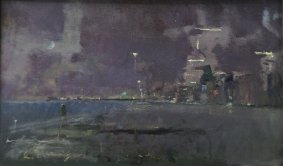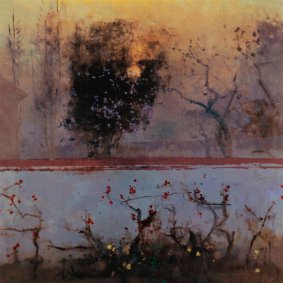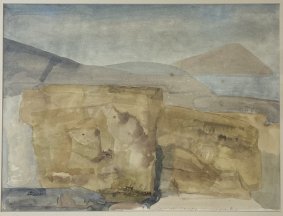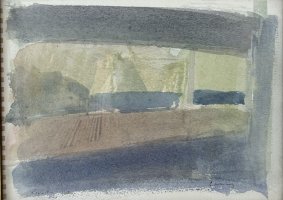Contact
- Rye Art Gallery
107 High Street, Rye
East Sussex. TN31 7JE - 01797 222433
- ryeartgallery@gmail.com
Fred Cuming RA
Fred Cuming RA (1930-2022)
There are many tributes that you can apply to Fred Cuming RA, from his raucous sense of humour, to his kindness and his sparkly blue eyes but for many who had the pleasure of knowing Fred it has been a sad and testing time.
We will of course be safe in the knowledge that the world will be left with a legacy, one that is rare and allows Fred to be in the fine company of the few great landscape painters that this country has produced. His ability to transport all who view his paintings to the experience of being in the landscape is unique and it is for that reason that his loss will truly be felt in the art world.
The landscapes are a skilled composition and like a harmonious song are clear but fading in parts, ranging as you move through the canvas. Unlike traditional landscapes where the skies are vivid or sublime, Cuming's landscapes reveal glorious skies that are never smooth or flat but are spacious and painted with infinite skill and immeasurable depth. The colours give us an indication of his scientific knowledge, there is an intensity to what appears at first to be a muted colour palette but reveal the diffusion and translucency of the sun breaking through the clouds.
This is an individual who spent time beneath the skies, watching, observing and depicting. This was an artist who supplemented his sketches with reading, there is a certainty and knowledge of the sky that the average individual would not know.
It seems strange when considering this, that whilst in discussion he would reveal he was not particularly good at school and was lucky to have been in National Service to give him some consistency and grounding. Perhaps the obliterated landscapes of South East London after the war had a disrupting effect on the young artist, it is a similar story for many others but it is also the reason he always looked upwards towards the sky.
Fred maneuvered successfully through art college eventually studying in the 1950s at the Royal College of Art under John Minton. A wonderful tutor who was a dynamic and bohemian character at the College, who often taught by example, painting alongside his students in the life room. A great loss must have been felt by Fred with Minton’s early death in 1957 not long after he had completed his studies. However, he put this knowledge to use when he began working at Walthamstow Art School, teaching drawing where he would inspire and insist on his students "drawing what you see!" Some of his protégés included Gus Cummins RA, Mick Rooney RA and Ian Dury.
He didn't rely on landscapes for inspiration but created a wonderful portfolio of still lives, prints, etchings and portraits, one of his favourites being the Stephen Hawking’s painting in the National Portrait Gallery. One can only imagine the naughty jokes they would have shared whilst this portrait was being painted. His still lives are wonderful and wispy, emotional and tactile, a gift that his son Daniel could also replicate. There was a sense when Danny’s Still Life with Lemons arrived back at the gallery after being framed a few weeks ago that Fred recognised this, viewing the painting with admiration but equally with pride.
We have been lucky to have known Fred but also to have seen and experienced his work and to get a sense of what Fred was seeking whilst he painted - perhaps John Ruskin maybe able to help us out with the words:
“Out of perfect light and motionless air, we find ourselves on a sudden brought under sombre skies, and into drifting wind; and with fickle sunbeams flashing in our face, or utterly drenched with a sweep of rain, we are reduced to track changes of the shadows on the grass, or watch the rents of twilight through angry cloud".
All enquiries: ryeartgallery@gmail.com
or telephone: 01797 222433

Rye Harbour Evening, 2020, oil, 42x63cm inc. frame - £6,250 NOW SOLD

Hastings Pier, Evening, 2020, oil, 43x63cm inc. frame - £6,250 NOW SOLD

Full Moon, Camber, 2020, oil, 95x95cm inc. frame - NOW SOLD

Morning Glory, 2020, oil, 37.5x42.5cm inc. frame - £4,300 NOW SOLD

Night Studio with Self Portrait, original 1978 etching reprinted 2015, edition 9/45 - £750 framed, £625 unframed

Wave, Camber, Oil, 51x 61cm - NOW SOLD

Rye Harbour Entry, 2022, oil, 38x43cm inc.frame - NOW SOLD

Evening Sky, Peasmarsh, oil, 4x12ins - £2,500 NOW SOLD

Japonica & Prunus, edition of 75, 2007, Signed limited edition silk screen on handmade paper - NOW SOLD

Lagoon Venice, edition of 75, Signed limited edition silk screen on handmade paper - £1,260

Etna, edition of 75, 2011, Signed limited edition silk screen on handmade paper - £1,125

September Garden, edition of 75, Signed limited edition silk screen on handmade paper - £1,200

Studio Evening Moonrise, edition of 75, Signed limited edition silk screen on handmade paper - £1,475 Please note: A/P, 6/10 was presented to HM Queen Elizabeth II in 2012 as part of the Diamond Jubilee Gift from the Royal Academy of Arts NOW SOLD

Waiting For The Ferry Fowey Harbour, edition of 75, 2009, Signed limited edition silk screen on handmade paper - £1,600

Winter Landscape Willows, edition of 75, Signed limited edition silk screen on handmade paper - £1,410

Thaw, edition of 75, Signed limited edition silk screen on handmade paper - £1,200

Albert Bridge, 1991, oil on board, 40x45cm inc. frame, NOW SOLD

Birds, oil on board, 22x26cm inc.frame, NOW SOLD

Flower study, oil on board, 29x34cm inc. frame - £2,500 NOW SOLD

Calais Beach, oil on board, 27x73cm inc. frame - £5,500

Brighton Pier from Bedroom Window, originally purchased from Rye Art Gallery on 1st November 1986, oil on board, 36x41cm inc. frame - POA

Studio Window, 1986, oil on board, 80x103cm inc. frame - NOW SOLD

Lyme Regis, circa 1972, drypoint etching - NOW SOLD

Winter Landscape II, special artists proof, signed limited edition silk screen on handmade paper - £1,500

Old George And Bonfire (Hastings Fishing Beach, circa 1986), oil on board, 56x49cm inc.frame - NOW SOLD

Lyme Regis, 1977, watercolour, 58x67cm inc. frame - £1,500

Reflection, Hastings Pier, watercolour, 22x27cm inc. frame - £400

Faust At Glyndebourne, oil on board, 25x25cm inc. frame - £1,800

Winter Beach Snowscape, Hythe, oil on board, 29x40cm inc. frame - £3,900

Dedication To Jenny, Christmas, 1993, oil on board, 29x51cm inc. frame - P.O.A

Sea And Sky Study, 1, watercolour, 39x44cm inc. frame - £400

Sea And Sky Study, 2, watercolour, 39x44cm inc. frame - £400






